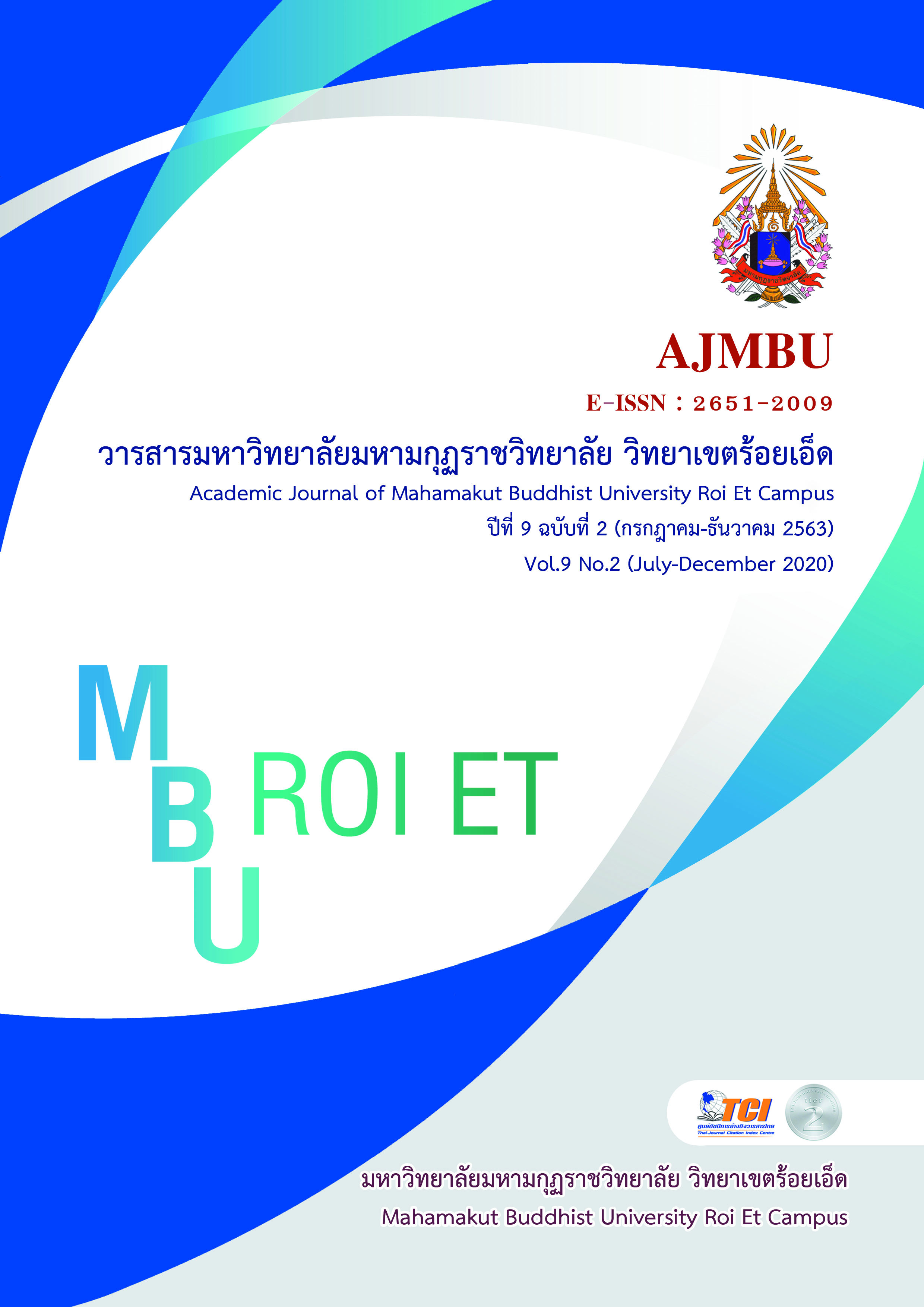Self-Development Guidelines for Teachers under the Jurisdiction of the Mahasarakham Office of Primary Education Area 1
Main Article Content
Abstract
The objectives of the research were to 1) study the current conditions and desirable conditions of self-development for teachers and 2) study self-development guidelines for teachers under the jurisdiction of the Mahasarakham Office of Primary Education Area 1. The research sample was composed of 280 teachers under the jurisdiction of the Mahasarakham Office of Primary Education Area 1, who were selected through a process of multi-stage random sampling. Data collection tools used for this investigation were a 5-point rating scale questionnaire, interview forms and forms to evaluate the consistency and suitability of the guidelines. Statistics used during data analysis were percentage, average, standard deviation and correlation coefficient.
The result of this study were found: 1)The results showed that there were 3 components and 28 indicators of self-development for teachers under the jurisdiction of the Mahasarakham Office of Primary Education Area 1. 2) The overall current condition of self-development among teachers under the jurisdiction of the Mahasarakham Office of Primary Education Area 1 was found to be at a moderate level. 3) The area of self-development for teachers under the jurisdiction of the Mahasarakham Office of Primary Education Area 1 found to be in the most need was ‘Creation of innovations to develop the organization and the profession’ followed by ‘Knowledge exchange and network creation’ and ‘Study and research of new knowledge. Overall, the consistency and suitability of guidelines for self-development of teachers under the jurisdiction of the Mahasarakham Office of Primary Education Area 1 were evaluated at the highest level. The possibility of the guidelines was evaluated at a high level. The individual component with the highest rating for suitability was ‘Study and research of new knowledge’, followed by ‘Knowledge exchange and network creation’ and ‘Creation of innovations to develop the organization and the profession’, respectively. The potential of all three components was rated at a high level.
Article Details
References
กระทรวงศึกษาธิการ. (2552). หลักสูตรแกนกลางการศึกษาขั้นพื้นฐาน พุทธศักราช 2551. กรุงเทพมหานคร : โรงพิมพ์ชุมนุมสหกรณ์การเกษตรแห่งประเทศไทย.
เกษมศักดิ์ ปราบณรงค์. (2560). การพัฒนาโปรแกรมเสริมสร้างสมรรถนะครูด้านการพัฒนาตนเอง สังกัดสำนักงานเขตพื้นที่การศึกษาประถมศึกษายโสธร เขต 1. วิทยานิพนธ์การศึกษามหาบัณฑิต. บัณฑิตวิทยาลัย : มหาวิทยาลัยมหาสารคาม.
บุญชม ศรีสะอาด. (2554). การวิจัยเบื้องต้น. กรุงเทพมหานคร : สุวีริยาสาส์น.
เบญจมินทร์ โคตรสุโน. (2561). การพัฒนาแนวทางการเสริมสร้างสมรรถนะด้านการพัฒนาตนเอง สังกัดสำนักงานเขตพื้นที่การศึกษาประถมศึกษาอุดรธานี เขต 4. วารสารบัณฑิตศึกษา มหาวิทยาลัยราชภัฏสกลนคร. 15(71). 179-187.
พิชญ์สินี พงษ์ภักดิ์. (2556). ปัญหาและความต้องการพัฒนาตนเองตามเกณฑ์มาตรฐานวิชาชีพครูของครูโรงเรียนในสังกัดสำนักงานเขตพื้นที่การศึกษาประถมศึกษาขอนแก่น เขต 5. การศึกษาค้นคว้าอิสระการศึกษามหาบัณฑิต สาขาวิชาการบริหารการศึกษา. มหาวิทยาลัยมหาสารคาม.
ลัดดาวัลย์ แก่นจักร. (2560). การพัฒนารูปแบบการเสริมสร้างสมรรถนะด้านการพัฒนาตนเองของครูโรงเรียนเอกชน ในสังกัดสำนักงานเขตพื้นที่การศึกษาประถมศึกษาสกลนคร เขต 2. วิทยานิพนธ์การศึกษามหาบัณฑิต. บัณฑิตวิทยาลัย : มหาวิทยาลัยมหาสารคาม.
วันวิสา อเนก. (2555). การพัฒนาตนเองของข้าราชการในกลุ่มเครือข่ายแกลงบูรพา สังกัดสำนักงานเขตพื้นที่การศึกษาประถมศึกษาระนอง เขต 2. วิทยานิพนธ์การศึกษามหาบัณฑิต. บัณฑิตวิทยาลัย : มหาวิทยาลัยบูรพา.
สำนักงานคณะกรรมการการศึกษาแห่งชาติ. (2545). พระราชบัญญัติการศึกษาแห่งชาติ พ.ศ. 2542 และที่แก้ไขเพิ่มเติม (ฉบับที่ 2) พ.ศ. 2545. กรุงเทพมหานคร : พริกหวานกราฟฟิก.
สำนักงานพัฒนาครูและบุคลากรทางการศึกษาขั้นพื้นฐาน. (2553). คู่มือการประเมินสมรรถนะครู (ฉบับแก้ไข). กรุงเทพมหานคร : สำนักงานคณะกรรมการการศึกษาขั้นพื้นฐาน.
Maslow, Abraham M. (1954). Motivation and Personality. New York : Harper and Row.


